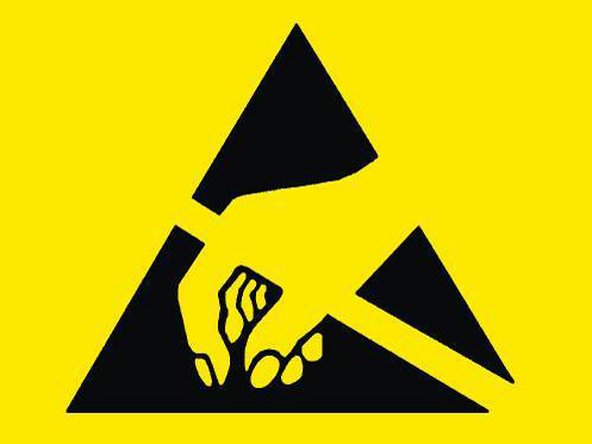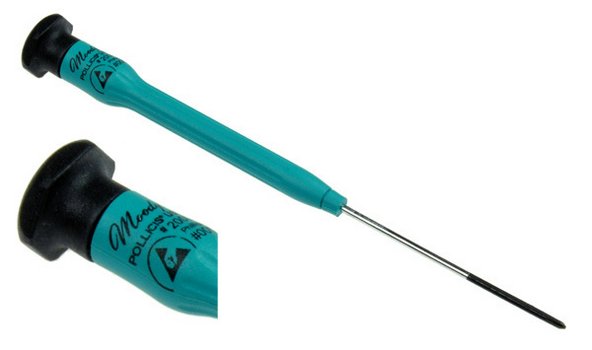Electrostatic discharge and novice electronics repair

Beware: a short stroll on your Dacron® carpet can load the surface of your skin and clothes with enough spare electrons to cook that RAM you just took out of its special little pink or silver bag. Recipes for Abbacchio Al Forno aside, cooking your RAM is something to avoid. If you are new to tinkering with electronics, you may not have heard of electrostatic discharge (ESD) safety procedures. ESD is a sudden electric shock that your electronic device may incur if it isn’t handled properly. As a rule of thumb, the smaller the components inside your device get, the more sensitive they are to those crackles and pops you hear on a dry day when you pet the cat.
Electronic components become smaller every year; so just about any electronic device you own has components that require proper care on your part before you start fiddling inside. Be it the innards of your smart phone or the logic board, RAM, or hard drive in your laptop, the free electrons on your skin are just itching to attack all those tiny semiconductors.
By the way, you and all the objects around you are exchanging static charges all the time. Don’t be fooled into thinking that just because you don’t see a spark, there is no energy transferred. That visible spark between your finger and a door knob may have contained several thousand volts, but some electronic components are sensitive to static discharge of less than one hundred volts. You are unlikely to see, feel, or hear these smaller (yet still potentially damaging) exchanges of charge. Just scooting your butt around in your chair can load up enough zap juice to cause mayhem.
Just the facts ma’am
So, every time you or other objects move around, making and breaking contact with various surfaces, a static charge may build up. A particular surface may hold or dissipate that charge depending on all sorts of factors, like relative humidity in the air, conductivity of the material, etc. If those details don’t put you to sleep and you want to know more, have a look at the web page of the Electrostatic Discharge Association. It’s loaded with detail mostly intended for folks in manufacturing who really need to keep ESD under control.
For the electronics repair novice, the key tidbit to keep in mind is that bad things happen when your electronic components (with one level of charge) suddenly come in contact with something with a different level of charge. Spare electrons on the surface try to find equilibrium and create havoc. If they rush from one object to another and some tiny electronics are in the way, the semiconductors get cooked. Yet when all components in your device are assembled, they share one big happy charge together. So there’s no problem until you start taking it all apart — that’s when the potential for different charges rears its ugly head.

The objective of ESD safe procedures and tools is to dissipate or equalize unequal charges before they can flow through delicate electronics, or to slow the exchange of that electrostatic charge enough so it does not cause damage. If your hands, work surface, tools, and electronic parts are all at the same charge or all connected to a decent ground, there will be no exchange of charge between them when they come in contact. This is the purpose of anti-static wrist straps and mats. Those special pink or silver plastic bags containing your new disk drive or RAM chip are designed to dissipate static charge slowly enough to prevent damage. The pink or silver plastic is neither a good conductor, which would dissipate an unequal charge too quickly, nor a good insulator, which would hold a potentially damaging charge for a long time. Likewise, the special plastic grips of ESD safe tools are intended to slowly dissipate an unequal charge. Used together with the right procedures, ESD safe tools and anti-static mats and wrist straps may keep your new RAM fresh and uncooked.
So what’s a novice to do?
A few simple precautions will help keep you from creating inadvertent paperweights:
- Unplug your electronic device.
- Remove rings, watches, and bracelets from your fingers and wrists.
- Ground your work surface. Lay down an anti-static mat and use its wire lead to connect to ground. This can be a water pipe or an unpainted metal part of a grounded appliance like a washing machine, dryer, or refrigerator. You may connect directly to the ground wire of an AC outlet but only if you are certain you know what you’re doing. You may wish to consult an electrician. Can’t get to a good ground? Then clip your mat to something big and conductive like the steel legs of a work bench. This at least gives you a charge reservoir to equalize everything with.
- Ground yourself. Wear an anti-static wrist strap and use its wire lead to connect to your anti-static mat.
- Keep your new parts in their pink or silver bags until you are ready to install them.
- Place all your bagged new parts on the anti-static mat before you work with them.
- Place your electronic device on the anti-static mat.
- Place your tools on the anti-static mat.
Everything, including your hands, should now have an equal charge and you can get to work. As you work keep a few things in mind:
- If your electronic device has a metal case, its charge should be equalized by just sitting on your anti-static mat. If your electronic device has a plastic case, touch a metal internal case component before you disconnect any internal parts. For example, removing the battery from a MacBook exposes its internal metal frame. Touching your grounded hand to these metal parts will equalize the charge of the internal components with you and your work surface. Touch those same internal metal frame parts regularly as you work, particularly just before swapping sensitive components like RAM sticks.
- Any parts that you may wish to keep should be placed in ESD safe pink or silver bags for storage.
- Caution: ESD safe procedures will not protect you from high voltage discharge from a CRT display or any other glass tube monitor or television. In addition, power supplies built into desktop CPUs or other devices contain capacitors with similar potential for high voltage discharge.
Once you have your device reassembled and working again, don’t forget to remove that silly-looking strap off your wrist. Then it’s time to shuffle across the carpet and zap the cat on the nose.*
* We do not condone the abuse of animals, even if it’s zapping your cat on the nose.




0 Comments